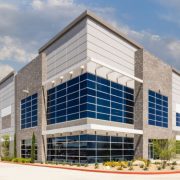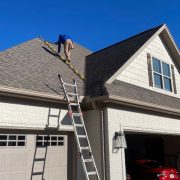The Critical Partnership: How Commercial Roofing and HVAC Systems Work Together
When it comes to commercial building systems, few partnerships are as crucial yet overlooked as the relationship between roofing and HVAC. These two major building components don’t just coexist, but they work symbiotically, each affecting the performance, efficiency, and longevity of the other. Understanding this relationship is essential for building owners, facility managers, and contractors who want to maximize building performance while minimizing costs and headaches.
Built to Bear the Load: Structural Interdependence
Commercial flat roofs face a challenge that residential roofs rarely encounter: supporting massive HVAC equipment. Modern rooftop units, chillers, condensers, and extensive ductwork can add thousands of pounds to a roof structure. This isn’t just about having a “strong enough” roof. It requires careful engineering to ensure proper load distribution and structural reinforcement.
The consequences of inadequate structural planning are severe. Overloaded roofs can sag, develop stress cracks, or in extreme cases, suffer catastrophic failure. Even minor structural movement can compromise both roofing membranes and HVAC equipment, leading to leaks, equipment misalignment, and premature system failures. Smart building planning addresses these structural requirements from the design phase, ensuring the roof structure can handle not just current equipment but potential future upgrades.
Timing Is Everything: Installation Coordination
The sequence of commercial construction creates unique challenges for the roofing-HVAC partnership. Installing HVAC equipment after commercial roof completion means cutting through the finished roofing system for each unit, creating multiple opportunities for water infiltration.
Proper curb installation, flashing integration, and weatherproofing around penetrations require coordination between roofing and mechanical contractors who understand each other’s criteria. A roofing contractor who doesn’t understand HVAC needs might create inadequate openings or use incompatible materials. Similarly, an HVAC contractor who doesn’t respect roofing integrity can create leak points that compromise the entire building envelope.
A commercial HVAC company that First Choice frequently partners with on commercial roofing projects is Xcell Williams Heating & Cooling. According to the company’s President, Casey Heinold, “The most successful projects involve early collaboration between trades with detailed plans, proper materials selection and clear responsibility assignments. Coordination and craftsmanship are essential for installing HVAC equipment on a roof quickly and correctly. The last thing a customer wants is a leaking roof. That’s why we use First Choice!”
Protecting Your Investment: Maintenance Access Considerations
Flat roofs offer convenient access to HVAC equipment, which is one reason rooftop installations are so popular in commercial applications. However, this accessibility comes with a hidden cost: the constant foot traffic from HVAC technicians can gradually damage roofing materials, leading to premature roof failure and unexpected repair costs.
The solution is proactive planning. Installing walkway pads, designated pathways, and equipment platforms protects the roofing membrane while providing safe, stable access for maintenance personnel. These protective measures might seem like an additional expense during construction, but they pay for themselves many times over by extending roof life and preventing damage-related repairs.
Building owners should also establish clear protocols for roof access, ensuring that all service personnel understand proper procedures for moving across the roof without causing damage.
Working Smarter, Not Harder: Energy Efficiency Synergy
The roofing system actively participates in building energy performance, with its thermal properties directly affecting HVAC workload. Reflective materials and proper insulation reduce cooling and heating demands, enabling more efficient system operation and lower energy costs. Conversely, poor roofing choices like dark, poorly insulated surfaces, can force even efficient HVAC systems to work overtime, driving up energy expenses. High-performing commercial buildings treat roofing and HVAC as complementary systems, designing both to work together for optimal efficiency.
Managing the Flow: Drainage and Water Management
While water management appears to be solely a roofing issue, HVAC systems significantly complicate drainage planning. Water produced by air conditioning units, cooling towers, and mechanical systems must be properly handled to avoid damage and preserve system performance. Poor coordination can result in ponding water, ice dams, and structural damage.
Successful installations integrate drainage from both systems to ensure water flows safely away from the building. Retrofits require special care since new equipment can change drainage flows or overburden aging systems.
Navigating the Fine Print: Warranty and Liability Overlap
One of the most complex aspects of the roofing-HVAC relationship involves warranties and liability. Most roofing warranties exclude damage caused by other trades, while HVAC warranties typically don’t cover issues related to improper installation or roofing problems. This creates a potential gray area at penetration points and equipment interfaces where problems could be attributed to either system.
Working with experienced contractors who understand these warranty implications is crucial. Here at 1st Choice Roofing and Construction, we handle roofing needs and other exterior work. Therefore, we have a unique understating of what needs to be done and how to coordinate closely with other trades. We also understand how to maintain warranty coverage while ensuring the system’s integrity. We also communicate clearly about responsibility boundaries and potential warranty implications before problems arise.
The Big Picture: Long-Term Planning Benefits
Understanding the roofing-HVAC relationship enables powerful long-term planning opportunities. Coordinating roof replacement with HVAC upgrades provides cost savings, reduces disruption, and allows optimization of equipment placement, structural support, and energy efficiency across both systems for better performance and longevity.
Problems between your commercial HVAC and roofing system can cause hidden costs that add up quickly.
Moving Forward: Best Practices for Success
The critical partnership between commercial roofing and HVAC systems requires understanding and careful planning. Building owners who recognize this relationship enjoy better performance, lower costs, and fewer long-term issues. Success depends on working with knowledgeable contractors, implementing proactive maintenance programs, and treating these systems as the integrated partnership they are.
In commercial building management, few relationships are as vital as the one between your roof and HVAC system. Understanding this partnership isn’t just good practice—it’s essential for building success.
Ready to optimize your commercial roofing and HVAC partnership? Contact 1st Choice Roofing and Construction today. Our experienced team understands how these systems work together and can help you plan, install, or maintain both for maximum performance and longevity. Don’t leave this crucial relationship to chance. Instead, partner with professionals who get it right the first time.










